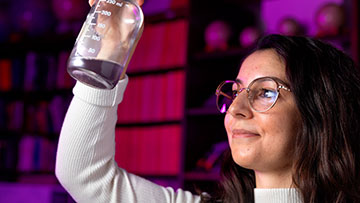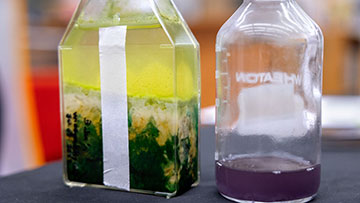
Lígia Fonseca Coelho cultivates bacteria samples in the lab. [Image: Ryan Young, Cornell University]
As humans accustomed to Earth and its place in the solar system, we associate lush green fields and tree canopies with the presence of life. But what would a landscape of living material look like on a planet orbiting a different type of star?
To aid searches for extraterrestrial surface life, researchers in the United States are studying the colors of earthly bacteria that don’t rely on chlorophyll for their photosynthetic needs (Mon. Not. R. Astron. Soc., doi: 10.1093/mnras/stae601). Reflectance spectra of these differently colored microbes could guide future studies of Earth-like extrasolar planets.
On Earth, these so-called purple bacteria flourish in aquatic environments, often without visible light. Astronomers and astrobiologists could use these organisms’ spectral signatures, which have not been widely collected in the past, to decipher whether exoplanets orbiting stars cooler than the sun might harbor life that can make food from infrared light.
Shades of “purple”
Due to the presence of carotenoids―biopigments that absorb energy for the food-generating process―purple bacteria can look brown or reddish instead of pure purple. One subset of these microbes, called purple sulfur bacteria, uses sulfur instead of water as a reducing agent. These organisms don’t produce oxygen as a byproduct of photosynthesis, as green plants on Earth do. Purple non-sulfur bacteria have different internal chemistry and are more flexible about their reducing agents.
Earthly plants that perform oxygenic photosynthesis absorb the red and blue parts of the visible light spectrum and reflect green. They evolved to depend on the plentiful radiation around the peak of the solar spectrum. Some scientists believe that purple bacteria populated a cooler, primeval Earth and might similarly thrive in a habitable zone around a red star that generates more infrared light than the sun.
Spectroscopic measurements

A collection of bacteria samples in the Space Sciences Building at Cornell University. [Image: Ryan Young, Cornell University]
Lígia Fonseca Coelho and her colleagues at Cornell University raised more than 20 cultures of purple bacteria, mostly sourced from wetlands in Massachusetts and New York, USA. The team also grew two cultures of “green” (photosynthesizing) cyanobacteria for comparative purposes.
Next, the team collected reflectance spectra from the individual cultures over the wavelength range of 400 to 2500 nm. The researchers took these spectra under two types of conditions: “fresh” (newly deposited on a sampling filter) and “dry” (after leaving the bacteria spread on a filter in the dark for a week). Extensive computer modeling helped the group place the spectra of the laboratory cultures in a wider context of possible exoplanet weather involving snow, oceans and clouds.
Coelho and her collaborators hope that their biopigment spectra will provide “surface biosignatures” that can guide astronomers searching for life on the more than 5,500 confirmed exoplanets discovered since 1995. The authors conclude: “While it is unknown whether life―or purple bacteria―can evolve on other worlds, purple might just be the new green in the search for surface life.”
